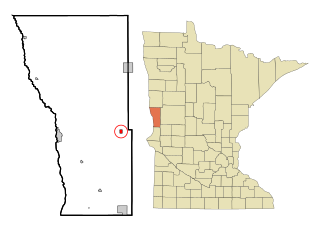
Wilkin County is a county in the U.S. state of Minnesota. As of the 2020 census, the population of Wilkin County was 6,506. Its county seat is Breckenridge. The county is named for Colonel Alexander Wilkin, a lawyer who served as Minnesota's U.S. marshal and was later killed in the Civil War.
Atherton Township is a township in Wilkin County, Minnesota, United States. The population was 155 at the 2000 census.
Bradford Township is a township in Wilkin County, Minnesota, United States. The population was 119 at the 2000 census.

Breckenridge is a city and county seat of Wilkin County, Minnesota, United States. The population was 3,430 at the 2020 census.
Breckenridge Township is a township in Wilkin County, Minnesota, United States. The population was 234 at the 2000 census.

Campbell is a city in Wilkin County, Minnesota, United States. The population was 164 at the 2020 census. It is part of the Wahpeton, ND-MN Micropolitan Statistical Area.
Campbell Township is a township in Wilkin County, Minnesota, United States. The population was 99 at the 2000 census.

Doran is a city in Wilkin County, Minnesota, United States. The population was 36 at the 2020 census. It is part of the Wahpeton, ND-MN Micropolitan Statistical Area.

Foxhome is a city in Wilkin County, Minnesota, United States. The population was 126 at the 2020 census. It is part of the Wahpeton, ND—MN Micropolitan Statistical Area.

Kent is a city in Wilkin County, Minnesota, United States. The population was 65 at the 2020 census. It is part of the Wahpeton, ND-MN Micropolitan Statistical Area.
McCauleyville Township is a township in Wilkin County, Minnesota, United States. The population was 56 at the 2000 census.
Meadows Township is a township in Wilkin County, Minnesota, United States. The population was 65 at the 2000 census.
Mitchell Township is a township in Wilkin County, Minnesota, United States. The population was 103 at the 2000 census.

Nashua is a city in Wilkin County, Minnesota, United States. The population was 67 at the 2020 census. It is part of the Wahpeton, ND-MN Micropolitan Statistical Area.
Prairie View Township is a township in Wilkin County, Minnesota, United States. The population was 215 at the 2000 census.
Roberts Township is a township in Wilkin County, Minnesota, United States. The population was 118 at the 2000 census.
Sunnyside Township is a township in Wilkin County, Minnesota, United States. The population was 143 at the 2000 census.
Tanberg Township is a township in Wilkin County, Minnesota, United States. The population was 68 at the 2000 census.

Wolverton is a city in Wilkin County, Minnesota, United States. The population was 128 at the 2020 census. It is part of the Wahpeton, ND—MN Micropolitan Statistical Area.
Wolverton Township is a township in Wilkin County, Minnesota, United States. The population was 130 at the 2000 census.












